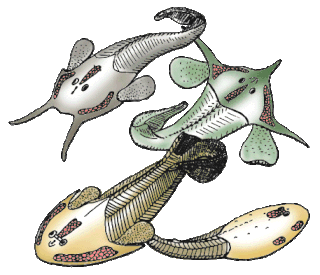
Conodonts are an extinct group of agnathan (jawless) vertebrates resembling eels, classified in the class Conodonta. For many years, they were known only from their tooth-like oral elements, which are usually found in isolation and are now called conodont elements. Knowledge about soft tissues remains limited. They existed in the world's oceans for over 300 million years, from the Cambrian to the beginning of the Jurassic. Conodont elements are widely used as index fossils, fossils used to define and identify geological periods. The animals are also called Conodontophora to avoid ambiguity.

Agnatha is an infraphylum of jawless fish in the phylum Chordata, subphylum Vertebrata, consisting of both living (cyclostomes) and extinct species. Among recent animals, cyclostomes are sister to all vertebrates with jaws, known as gnathostomes.

Gnathostomata are the jawed vertebrates. Gnathostome diversity comprises roughly 60,000 species, which accounts for 99% of all living vertebrates, including humans. In addition to opposing jaws, living gnathostomes have true teeth, paired appendages, the elastomeric protein of elastin, and a horizontal semicircular canal of the inner ear, along with physiological and cellular anatomical characters such as the myelin sheaths of neurons, and an adaptive immune system that has the discrete lymphoid organs of spleen and thymus, and uses V(D)J recombination to create antigen recognition sites, rather than using genetic recombination in the variable lymphocyte receptor gene.

Ostracoderms are the armored jawless fish of the Paleozoic Era. The term does not often appear in classifications today because it is paraphyletic and thus does not correspond to one evolutionary lineage. However, the term is still used as an informal way of loosely grouping together the armored jawless fishes.

Thelodonti is a class of extinct Palaeozoic jawless fishes with distinctive scales instead of large plates of armor.
Derek Ernest Gilmor Briggs is an Irish palaeontologist and taphonomist based at Yale University. Briggs is one of three palaeontologists, along with Harry Blackmore Whittington and Simon Conway Morris, who were key in the reinterpretation of the fossils of the Burgess Shale. He is the Yale University G. Evelyn Hutchinson Professor of Geology and Geophysics, Curator of Invertebrate Paleontology at Yale's Peabody Museum of Natural History, and former Director of the Peabody Museum.

In the geologic time scale, the Changhsingian or Changxingian is the latest age or uppermost stage of the Permian. It is also the upper or latest of two subdivisions of the Lopingian Epoch or Series. The Changhsingian lasted from 254.14 to 251.9 Ma ago. It is preceded by the Wuchiapingian age/stage and is followed by the Induan age/stage.

In the geologic timescale, the Olenekian is an age in the Early Triassic epoch; in chronostratigraphy, it is a stage in the Lower Triassic series. It spans the time between 251.2 Ma and 247.2 Ma. The Olenekian is sometimes divided into the Smithian and the Spathian subages or substages. The Olenekian follows the Induan and is followed by the Anisian.
Jacques Armand Gauthier is an American vertebrate paleontologist, comparative morphologist, and systematist, and one of the founders of the use of cladistics in biology.

Philip Conrad James Donoghue FRS is a British palaeontologist and Professor of Palaeobiology at the University of Bristol.
Emily Rayfield is a British palaeontologist, who is a Professor in Palaeobiology in the School of Earth Sciences at the University of Bristol.
Richard John Aldridge was a British palaeontologist and academic, who was Bennett Professor of Geology at the University of Leicester.
Mark Andrew Purnell is a British palaeontologist, Professor of Palaeobiology at the University of Leicester.
Ivan Sansom is a British palaeontologist, Senior Lecturer in Palaeobiology at the University of Birmingham. His research primarily has focused on the conodont palaeobiology and the early Palaeozoic radiation of vertebrates.
The Norian is a division of the Triassic Period. It has the rank of an age (geochronology) or stage (chronostratigraphy). It lasted from ~227 to 208.5 million years ago. It was preceded by the Carnian and succeeded by the Rhaetian.

The evolution of fish began about 530 million years ago during the Cambrian explosion. It was during this time that the early chordates developed the skull and the vertebral column, leading to the first craniates and vertebrates. The first fish lineages belong to the Agnatha, or jawless fish. Early examples include Haikouichthys. During the late Cambrian, eel-like jawless fish called the conodonts, and small mostly armoured fish known as ostracoderms, first appeared. Most jawless fish are now extinct; but the extant lampreys may approximate ancient pre-jawed fish. Lampreys belong to the Cyclostomata, which includes the extant hagfish, and this group may have split early on from other agnathans.
Jerzy Dzik is a Polish paleontologist.

Susannah "Susie" Catherine Rose Maidment is a British palaeontologist at the Natural History Museum, London. She is internationally recognised for her research on ornithischian dinosaur evolution, and was awarded the 2016 Hodson Award of the Palaeontological Association and the 2017 Lyell Fund of the Geological Society of London. She was featured as a 2019 National Geographic Women of Impact.
Richard James Butler is a vertebrate palaeontologist at the University of Birmingham, where he holds the title of professor of palaeobiology. His research focuses on ornithischian dinosaur evolution, dinosaur origins, and fossil tetrapod macroevolution.

Panderodus Is an extinct genus of jawless fish belonging to the order Conodonta. This genus had a long temporal range, surviving from the middle Ordovician to late Devonian. In 2021, extremely rare body fossils of Panderodus from the Waukesha Biota were described, and it revealed that Panderodus had a more thick body compared to the more slender bodies of more advanced conodonts. It also revealed that this conodont was a macrophagous predator, meaning it went after large prey.










